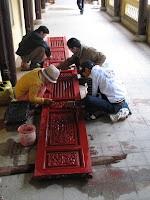



Arrived Hue at 11:30 AM. We have only a half day to see the Citadel, Thien Mu Pagoda and monastery and the Tu Doc Tomb.
First the Citadel. Built in the late 1800's and designed by the French for the then current emperor. It is a formidable fortress with multiple moats, limited gateways to restrict access and numerous strategically located defensive towers. In 1968, the North Vietnamese and Viet Cong captured the Hue Citadel during the TET new year celebration when a cease fire had been agreed upon. The Viet Cong flag flew from the predominant flag staff shown it the attached picture....casualties after the fight included 5,000 NV and VC, 1,500 South Vietnamese soldiers and 150 US military, primarily US marines. 1000's South Vietnamese soldiers, civilian sympathizers, monks and priests were executed. Our guide, Than, had old pictures of the Citadel dating back to the 1930s. Although in black & white, you can see the beauty and expansiveness of the entire complex. After seeing the Citadel, one can clearly understand why it was so difficult to dislodge the NV and VC. Today, the Citadel is about 40% restored after suffering severe damage in 1948 caused by the French and the remaining damage from the 1968 TET fighting. It is a UNESCO Heritage site and one of the pictures depicts part of the restoration effort.
From the Citadel we sailed down the Perfume river to the Thien Mu pagoda which is a Mahayana Buddhist monastery. There are 3 major Buddhist sects, Teravada (Sri Lanka, Thailand Lao, Cambodia, South Viet Nam), Mahayana (China, Japan, North Viet Nam) and the Tibetan Buddhist. Notice the difference in the Temple's architecture, 7 tiered roof vs a 1 or 2 tiered roof. The young novice monks wear gray outfits and their head is bald except for a long hair tassel. The older monks wear a multitude of different robes, one gray or yellow or saffron. Notice the Buddhist statute is the jolly, chubby Buddha ...different from the ones you saw from Lao and Thailand. The car is the car that drove a monk from this monastery to, I believe, the streets of Saigon where he burned himself to death...one of the most vivid pictures that came out of the VN war.













No comments:
Post a Comment